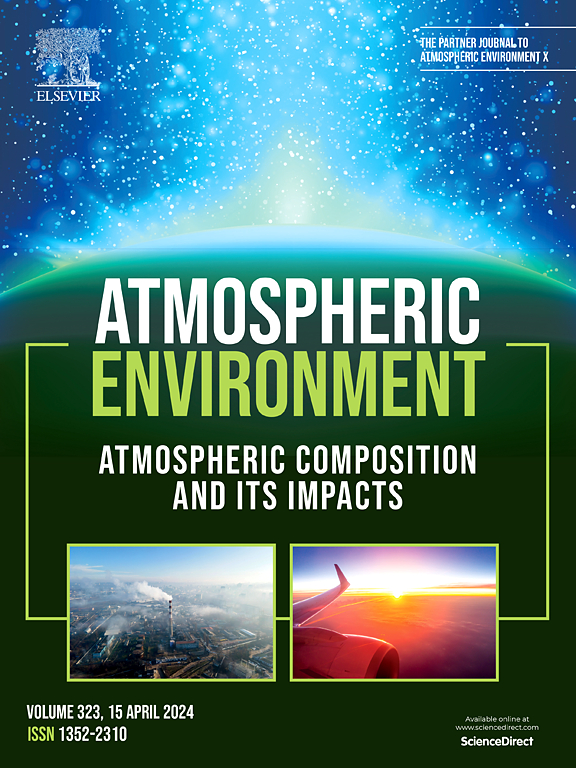An advanced method to evaluate population-weighted exposure of PM2.5-bound chromium (Cr): High-spatial resolved simulation of bioaccessible concentrations
IF 4.2
2区 环境科学与生态学
Q2 ENVIRONMENTAL SCIENCES
引用次数: 0
Abstract
Chromium (Cr) in fine particulate matter (PM2.5) poses a significant environmental health risk. However, current exposure assessments are constrained by insufficient spatial resolution and the neglect of bioaccessible fractions (Bio-Cr). In this study, we developed an advanced method to evaluate high-spatial resolution population-weighted exposure of PM2.5-bound Cr and its bioaccessible fraction (Bio-Cr). By integrating the Community Multiscale Air Quality (CMAQ) model and Land Use Regression (LUR) model through an uncertainty-weighted approach, the coupled model overcomes the limitations of individual models. The method was applied to a Chinese megacity. It captured distinct spatial heterogeneity in Cr and Bio-Cr distributions, with hotspots aligning with industrial and high-traffic areas. The coupled model revealed a pronounced belt-like distribution of Cr concentrations in central urban areas, with a peak value of 0.016 μg/m3, and Bio-Cr concentrations were generally lower, reaching up to 0.011 μg/m3. The population-weighted exposure assessment indicated that high-exposure areas for both Cr and Bio-Cr were primarily located in densely populated urban districts, with exposure risks significantly exceeding the citywide average, highlighting the necessity of targeted pollution control strategies. Additionally, this study introduced a bioavailability species allocation coefficient for Bio-Cr simulation in CMAQ, providing a new perspective for simulating bioaccessible metal concentrations in chemical transport models. To our knowledge, this is the first study to integrate CMAQ and LUR models for high-resolution simulation of bioaccessible metal concentrations. The coupled model provided a framework for estimating bioaccessible heavy metal exposure, offered a scientific basis for epidemiological and health impact research.
一种评估pm2.5结合铬(Cr)人群加权暴露的先进方法:生物可达浓度的高空间分辨率模拟
细颗粒物(PM2.5)中的铬(Cr)具有重大的环境健康风险。然而,目前的暴露评估受到空间分辨率不足和忽视生物可及部分(Bio-Cr)的限制。在这项研究中,我们开发了一种先进的方法来评估pm2.5结合的Cr及其生物可达分数(Bio-Cr)的高空间分辨率人群加权暴露。通过不确定性加权方法将社区多尺度空气质量(CMAQ)模型和土地利用回归(LUR)模型进行整合,克服了单个模型的局限性。该方法应用于中国的一个特大城市。Cr和Bio-Cr分布具有明显的空间异质性,热点与工业和高交通量区域一致。耦合模型显示,中心城区Cr浓度呈明显的带状分布,峰值为0.016 μg/m3,生物Cr浓度普遍较低,最高可达0.011 μg/m3。人口加权暴露评估结果表明,Cr和Bio-Cr高暴露区主要分布在人口密集的城区,暴露风险显著高于全市平均水平,表明有针对性的污染控制策略是必要的。此外,本研究还引入了生物可利用性物种分配系数用于CMAQ中生物可达性金属浓度模拟,为化学运输模型中生物可达性金属浓度模拟提供了新的视角。据我们所知,这是第一次将CMAQ和LUR模型集成到生物可及金属浓度的高分辨率模拟中。该耦合模型为生物可及性重金属暴露评估提供了框架,为流行病学和健康影响研究提供了科学依据。
本文章由计算机程序翻译,如有差异,请以英文原文为准。
求助全文
约1分钟内获得全文
求助全文
来源期刊

Atmospheric Environment
环境科学-环境科学
CiteScore
9.40
自引率
8.00%
发文量
458
审稿时长
53 days
期刊介绍:
Atmospheric Environment has an open access mirror journal Atmospheric Environment: X, sharing the same aims and scope, editorial team, submission system and rigorous peer review.
Atmospheric Environment is the international journal for scientists in different disciplines related to atmospheric composition and its impacts. The journal publishes scientific articles with atmospheric relevance of emissions and depositions of gaseous and particulate compounds, chemical processes and physical effects in the atmosphere, as well as impacts of the changing atmospheric composition on human health, air quality, climate change, and ecosystems.
 求助内容:
求助内容: 应助结果提醒方式:
应助结果提醒方式:


